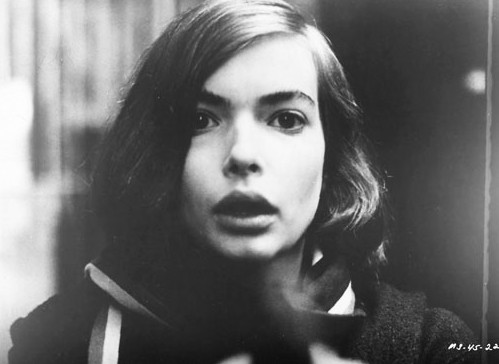 ★★★★★
★★★★★
“Dark Angel.”
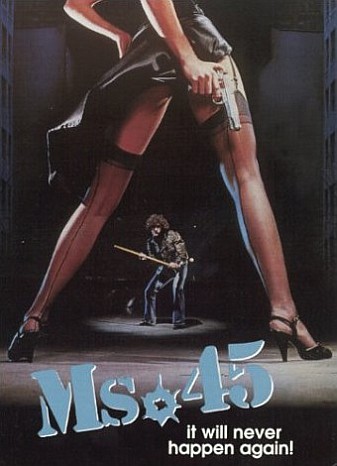
 Abel Ferrara is one of the most interesting of American film-makers, with an uncompromising vision that has seen him almost entirely shut out of mainstream cinema: the closest he’s come to a Hollywood movie was his Invasion of the Body-Snatchers remake, which was a failure on just about every level. Instead, he’s been on the outside, looking in, with films that range from the brilliant to the near-unwatchable. You never know what you’re going to get. It can be something raw and amazing, like Bad Lieutenant, or it can be a garbled, self-indulgent mess, such as his attempt to adapt William Gibson’s New Rose Hotel.
Abel Ferrara is one of the most interesting of American film-makers, with an uncompromising vision that has seen him almost entirely shut out of mainstream cinema: the closest he’s come to a Hollywood movie was his Invasion of the Body-Snatchers remake, which was a failure on just about every level. Instead, he’s been on the outside, looking in, with films that range from the brilliant to the near-unwatchable. You never know what you’re going to get. It can be something raw and amazing, like Bad Lieutenant, or it can be a garbled, self-indulgent mess, such as his attempt to adapt William Gibson’s New Rose Hotel.
Ms. 45 falls firmly into the first category, held together by an amazing, luminescent performance from the then 17-year old Zoe Tamerlis [a.k.a. Zoe Lund], whose character Thana is entirely mute – except for one word, whispered in the final scene. She works in a garment factory, run by sleazy owner Albert (Sinkys): one day, she is raped on the way home. Worse follows, as when she stumbles in to her apartment, another intruder is there, and violates her again. However, with the aid of a convenient domestic appliance, she kills him – and now possesses his gun, with which she can take on, single-handed, the men she now perceives as threats.
As Thana’s mental state disintegrates, however, her action gradually shift away from justified. While the viewer initially sympathizes with her, and cheers her on, it slowly becomes apparent that she has become entirely unhinged, paranoid and delusional. She goes from reaction to pro-action, dressing up and going out with the specific intent of luring men in and killing them. In many ways, Thana ends up worse than those who triggered her rage, spiralling down into what are basically random acts of violence: Tamerlis had, allegedly, been a victim of rape the previous year by a professor at Mount Holyoke College, and did not report it. As Ferrara put it, “Women are brought up in a male dominated society. You’re being raped every day, one way or another. That is the metaphor of the film.”
 Hmm. While I can acknowledge the political subtext in Thana’s muteness [especially since it appears largely to be psychological, going by the last scene], I’m not quite sure how seriously I take this claim overall, given Ferrara actually plays one of the rapists, and a large percentage of the time is spent objectifying and fetishizing his lead actress, to the extent where Chris felt she looked like a supporting actress in a Robert Palmer video. Perhaps the most memorably instance of this is Thana, dressing up as a nun – but one that also wears stocking and suspenders – before heading out to a Halloween party. With her blood-red lipstick, she kisses each of the bullets before loading them into her gun, a sequence which tells us much about Ferrara’s repressed Catholicism [also apparently rampant in Lieutenant, where both Ferrara and Lund worked on the script], as well as paying homage to the other great New York street-sweeper, Travis Bickle from Taxi Driver.
Hmm. While I can acknowledge the political subtext in Thana’s muteness [especially since it appears largely to be psychological, going by the last scene], I’m not quite sure how seriously I take this claim overall, given Ferrara actually plays one of the rapists, and a large percentage of the time is spent objectifying and fetishizing his lead actress, to the extent where Chris felt she looked like a supporting actress in a Robert Palmer video. Perhaps the most memorably instance of this is Thana, dressing up as a nun – but one that also wears stocking and suspenders – before heading out to a Halloween party. With her blood-red lipstick, she kisses each of the bullets before loading them into her gun, a sequence which tells us much about Ferrara’s repressed Catholicism [also apparently rampant in Lieutenant, where both Ferrara and Lund worked on the script], as well as paying homage to the other great New York street-sweeper, Travis Bickle from Taxi Driver.
Certainly, Tamerlis’s reading of the film is rather different. [Spoiler alert] “No, Ms. 45 is not about women’s liberation, any more than it is about mutes’ liberation, or garment workers’ liberation, or your liberation, or my own. Notice that her climactic victim is not a rapist in the clinical sense. He is her boss. The real rapist. Our real rapist… Ms. 45 presents a humble, yet well-crafted metaphor for rebellion of the any-sexed oppressed. But the gun was put in a woman’s hand. A woman carried that universal message, and so it was all the more powerful. It made us shiver. Male and female. Different timbres and temperatures of shiver, but shiver all round.”
Running counter to that, or perhaps lending it an additional depth, is that the one who stops Thana, in effect betraying her, is one of her own. It’s a woman and a fellow garment worker, her former friend Laurie (Stuto), who stabs her in the back, literally – a metaphor that I’m certain was not accidental, any more than the phallic positioning of the knife at Laurie’s crotch. [End spoilers] The subtext there seems to be that the oppressed can not be trusted to stick together in their battle against the oppressor, even though Laurie is a strong-enough personality in her own way. She certainly has no problem responding in kind to the barrage of verbal harrassment she and Thana suffer as they walk home from work. Our heroine, meanwhile, has ‘victim’ written all over her in the early stages of the film, though the strength she eventually finds and displays, is clearly in a radically different and anti-social direction.
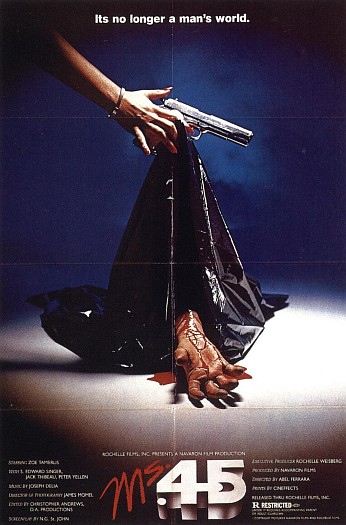 There are certainly holes in the plot logic. Where is Thana getting all the bullets from, and why is she such a crack-shot, despite presumably having never having handled a gun before? Yet these are in step with the pitch-black tongue-in-cheek humour the film contains: witness the long, rambling monologue inflicted on Thana by a guy she meets in a bar [her muteness making her the ultimate good listener]. I laughed like a drain at the sequence where Thana tries to get her landlady’s dog run over in traffic, as its nosiness concerning the severed body-parts round her appartment poses a threat. And when disposing of said parts, there’s surely nothing that you want to hear less, than for someone to shout after you, “Hey, lady! You dropped your bag!”
There are certainly holes in the plot logic. Where is Thana getting all the bullets from, and why is she such a crack-shot, despite presumably having never having handled a gun before? Yet these are in step with the pitch-black tongue-in-cheek humour the film contains: witness the long, rambling monologue inflicted on Thana by a guy she meets in a bar [her muteness making her the ultimate good listener]. I laughed like a drain at the sequence where Thana tries to get her landlady’s dog run over in traffic, as its nosiness concerning the severed body-parts round her appartment poses a threat. And when disposing of said parts, there’s surely nothing that you want to hear less, than for someone to shout after you, “Hey, lady! You dropped your bag!”
Chris, who lived in the Big Apple during the early-80’s, can also attest to the attitudes and dialogue as being authentic Noo Yawk, and the film does an excellent job of portraying the city as a predatory jungle, with a threat lurking behind every corner, especially for someone as attractive as Thana. Of course, “threat” is relative, and by the end, our heroine is the biggest threat – albeit only to those with a Y-chromosome, and the question of whether they deserve it or not is, to some degree, debatable. Still, in the words of the great philosophers, Paul Cook, Steve Jones and Ronny Biggs, “No-one is innocent.” Particularly in these days of movies produced by bean-counters, it’s refreshing to see a film that eschews a black-and-white approach in favor of an arc that takes us with a character as they journey into somewhere very dark and unpleasant, without needing to resolve things in a manner best described as, “…and they all lived happily ever after.”
[The pics and quotes here largely come from zoelund.com, a tribute site apparently run by Zoe’s ex-husband.]
Random notes
- Tamerlis used to show up to some screenings of the film [above, outside the Nuart theater in Los Angeles] and discuss the social and political implications of the movie afterwards with the audience.
- Which must have been interesting, as even the grindhouse theaters that were the movie’s natural home found it difficult viewing. In Cult Movies 2, Danny Peary says of the film, “Never has a 42nd Street theater been so quiet and disciplined as when Thana went through her rounds and murdered every offensive male who crossed her path… Unexpectedly, the men who had whooped all through Amin and the obscenely gory previews of Dr. Butcher, whimpered worrisomely “Oh, my God” and slumped in their seats and shut up.”
- It’s still unavailable in the United Kingdom except in a version where the rape scenes are cut by one minute, 42 seconds. Even the 2000 US DVD was re-edited: the cuts include changes to the first rape featuring Ferrara’s cameo, which is split by an insert shot from a later scene, the second rape omits a line “This oughta make you talk, huh?” and the climatic shoot-out removes an on-screen murder, which now occurs off-screen.
- The film inspired a song by L7, with the same title: “She’s got a gun, just make her day: don’t fuck with her, she’ll blow you away. She walks the streets at night and they think she is a whore. She’s gotta deal with you – she’s gonna even out the score.” The less well-known Dandi Wind also wrote a song called Ms. 45: “Today I bought a gun, Now I’m dressed just like a nun.”
- “According to Tamerlis, her performance in Angel of Vengeance provoked a sniper attack on her in New York, wounding her.” — 1983 Virgin Film Yearbook
- While Tamerlis experienced some success as a screenwriter and actress [Larry Cohen’s Special Effects is certainly worth checking out], she was a long-time drug user first of heroin and then cocaine. This contributed to her death of heart failure in Paris, in 1999.
Dir: Abel Ferrara
Stars: Zoe Tamerlis, Albert Sinkys, Darlene Stuto, Helen McGara
a.k.a. Angel of Vengeance
 This one popped out of nowhere, on a box-set of discs called Drive-In Cult Classics: most of these were unremarkable double-feature fillers, and this started off looking the same way, Kim (Lansing) is fed up with life: she’s still in high-school at age 18, is about to flunk it, has no money, just lost her boyfriend (Taylor), her father hung himself and her mom’s a total bitch. Finally, she opts to use her natural resources (if you know what I mean, and I think you do) to resolve these issues – though when her mother suggested Kim get a job, I’m not sure she meant as a whore working in the back of a VW van for the ultra-sleazy Tony (Mann). Her ‘popularity’ there lets her move up to work for the slightly-less sleazy Lance (Howard). Which is where the film takes an abrupt right turn, as she discovers a taste for killing – not least on her former pimp – and starts work as, to use one of the movie’s alternate titles, a high-school hit girl.
This one popped out of nowhere, on a box-set of discs called Drive-In Cult Classics: most of these were unremarkable double-feature fillers, and this started off looking the same way, Kim (Lansing) is fed up with life: she’s still in high-school at age 18, is about to flunk it, has no money, just lost her boyfriend (Taylor), her father hung himself and her mom’s a total bitch. Finally, she opts to use her natural resources (if you know what I mean, and I think you do) to resolve these issues – though when her mother suggested Kim get a job, I’m not sure she meant as a whore working in the back of a VW van for the ultra-sleazy Tony (Mann). Her ‘popularity’ there lets her move up to work for the slightly-less sleazy Lance (Howard). Which is where the film takes an abrupt right turn, as she discovers a taste for killing – not least on her former pimp – and starts work as, to use one of the movie’s alternate titles, a high-school hit girl.




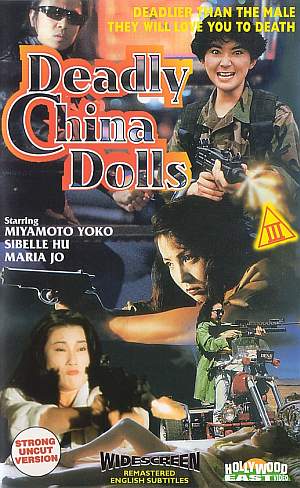
 The action is even more copious than the nudity however, and not bad, though one suspects a fair amount of doubling for the main actresses is going on. Despite Ho’s reputation as a complete hack [some of his films consist entirely of footage spliced together from other movies], he knows the right buttons for action heroine fans, and how to push most of them. On what I strongly suspect was a poverty-row budget – you don’t go to the Phillippines for the scenery – the movie delivers an impressive quantity of action, mixing firearm-toting and martial-arts battles to decent enough effect. All of the actresses get their moments to remember: a massacre in a restaurant and a supermarket shoot-out stand out in particular, as well as the roof-top fight between Hu and Yuen shown on the left.
The action is even more copious than the nudity however, and not bad, though one suspects a fair amount of doubling for the main actresses is going on. Despite Ho’s reputation as a complete hack [some of his films consist entirely of footage spliced together from other movies], he knows the right buttons for action heroine fans, and how to push most of them. On what I strongly suspect was a poverty-row budget – you don’t go to the Phillippines for the scenery – the movie delivers an impressive quantity of action, mixing firearm-toting and martial-arts battles to decent enough effect. All of the actresses get their moments to remember: a massacre in a restaurant and a supermarket shoot-out stand out in particular, as well as the roof-top fight between Hu and Yuen shown on the left. ★★★★★
★★★★★
 Abel Ferrara is one of the most interesting of American film-makers, with an uncompromising vision that has seen him almost entirely shut out of mainstream cinema: the closest he’s come to a Hollywood movie was his Invasion of the Body-Snatchers remake, which was a failure on just about every level. Instead, he’s been on the outside, looking in, with films that range from the brilliant to the near-unwatchable. You never know what you’re going to get. It can be something raw and amazing, like Bad Lieutenant, or it can be a garbled, self-indulgent mess, such as his attempt to adapt William Gibson’s New Rose Hotel.
Abel Ferrara is one of the most interesting of American film-makers, with an uncompromising vision that has seen him almost entirely shut out of mainstream cinema: the closest he’s come to a Hollywood movie was his Invasion of the Body-Snatchers remake, which was a failure on just about every level. Instead, he’s been on the outside, looking in, with films that range from the brilliant to the near-unwatchable. You never know what you’re going to get. It can be something raw and amazing, like Bad Lieutenant, or it can be a garbled, self-indulgent mess, such as his attempt to adapt William Gibson’s New Rose Hotel. Hmm. While I can acknowledge the political subtext in Thana’s muteness [especially since it appears largely to be psychological, going by the last scene], I’m not quite sure how seriously I take this claim overall, given Ferrara actually plays one of the rapists, and a large percentage of the time is spent objectifying and fetishizing his lead actress, to the extent where Chris felt she looked like a supporting actress in a Robert Palmer video. Perhaps the most memorably instance of this is Thana, dressing up as a nun – but one that also wears stocking and suspenders – before heading out to a Halloween party. With her blood-red lipstick, she kisses each of the bullets before loading them into her gun, a sequence which tells us much about Ferrara’s repressed Catholicism [also apparently rampant in Lieutenant, where both Ferrara and Lund worked on the script], as well as paying homage to the other great New York street-sweeper, Travis Bickle from Taxi Driver.
Hmm. While I can acknowledge the political subtext in Thana’s muteness [especially since it appears largely to be psychological, going by the last scene], I’m not quite sure how seriously I take this claim overall, given Ferrara actually plays one of the rapists, and a large percentage of the time is spent objectifying and fetishizing his lead actress, to the extent where Chris felt she looked like a supporting actress in a Robert Palmer video. Perhaps the most memorably instance of this is Thana, dressing up as a nun – but one that also wears stocking and suspenders – before heading out to a Halloween party. With her blood-red lipstick, she kisses each of the bullets before loading them into her gun, a sequence which tells us much about Ferrara’s repressed Catholicism [also apparently rampant in Lieutenant, where both Ferrara and Lund worked on the script], as well as paying homage to the other great New York street-sweeper, Travis Bickle from Taxi Driver. There are certainly holes in the plot logic. Where is Thana getting all the bullets from, and why is she such a crack-shot, despite presumably having never having handled a gun before? Yet these are in step with the pitch-black tongue-in-cheek humour the film contains: witness the long, rambling monologue inflicted on Thana by a guy she meets in a bar [her muteness making her the ultimate good listener]. I laughed like a
There are certainly holes in the plot logic. Where is Thana getting all the bullets from, and why is she such a crack-shot, despite presumably having never having handled a gun before? Yet these are in step with the pitch-black tongue-in-cheek humour the film contains: witness the long, rambling monologue inflicted on Thana by a guy she meets in a bar [her muteness making her the ultimate good listener]. I laughed like a 
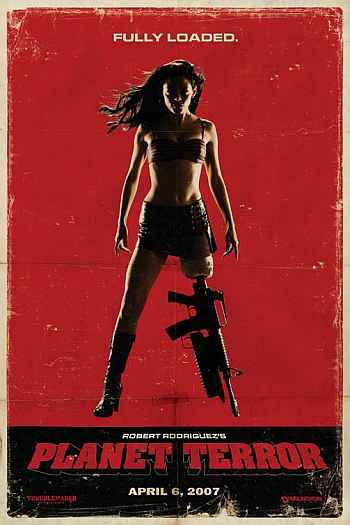 Grindhouse harkens back to an earlier time, when the only way to see cult or obscure movies was at your local fleabag cinema or drive-in. There was an entire industry of low-budget studios, like AIP, set up to create product for these outlets: knowing they couldn’t hope to compete in the areas of stars or general quality, they resorted instead to the old stand-bys of sex and violence. They flourished, roughly from the sixties to the end of the seventies, but the steady rise of home-entertainment media spelt their death-knell – at least as far as theatrical releases went. However, their films were an influence on many film-makers, and some of them have teamed up to bring you this love-letter to the genre, of the sort probably not seen for a couple of decades.
Grindhouse harkens back to an earlier time, when the only way to see cult or obscure movies was at your local fleabag cinema or drive-in. There was an entire industry of low-budget studios, like AIP, set up to create product for these outlets: knowing they couldn’t hope to compete in the areas of stars or general quality, they resorted instead to the old stand-bys of sex and violence. They flourished, roughly from the sixties to the end of the seventies, but the steady rise of home-entertainment media spelt their death-knell – at least as far as theatrical releases went. However, their films were an influence on many film-makers, and some of them have teamed up to bring you this love-letter to the genre, of the sort probably not seen for a couple of decades.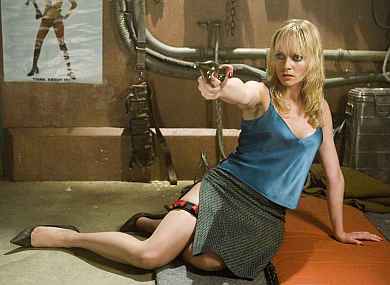 There’s a fine sense of escalation, from the relatively-subdued opening, through to the insane climax, in which Cherry – now fitted with an automatic weapon in place of a limb which was torn off her during an earlier attack – takes on an entire army of the undead. Ludicrous? Over-the-top? Nonsensical? Hell, yes. Wouldn’t have it any other way. About the only weakness is a tendency to go overboard with the trappings of grindhouse flicks, such as missing reels, scratched film, etc. far beyond the point at which it’s amusing. We get it. I said, we get it. Thank you. Fortunately, the DVD should have the “restored” i.e. un-screwed with version.
There’s a fine sense of escalation, from the relatively-subdued opening, through to the insane climax, in which Cherry – now fitted with an automatic weapon in place of a limb which was torn off her during an earlier attack – takes on an entire army of the undead. Ludicrous? Over-the-top? Nonsensical? Hell, yes. Wouldn’t have it any other way. About the only weakness is a tendency to go overboard with the trappings of grindhouse flicks, such as missing reels, scratched film, etc. far beyond the point at which it’s amusing. We get it. I said, we get it. Thank you. Fortunately, the DVD should have the “restored” i.e. un-screwed with version.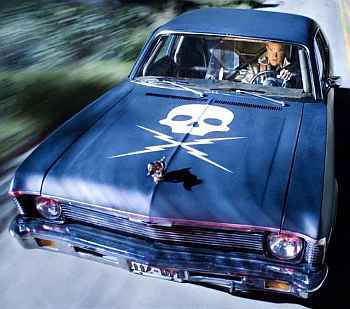 This section has the usual problem of Tarantino movies: he’s in love with his own dialogue, especially during an immensely-talky first half. And making the problem worse, the words never seem like they’re coming out of the characters’ mouths, but it is all too easy to imagine Quentin Tarantino saying them. Self-indulgent, meaningless drivel, full of pop culture references, he believes will make you think, “How clever!” – unfortunately, the result is closer to “What a poser!” This gets old really quickly, and when things get going in the second half, it’s a blessed relief. If you need to use the bathroom, quite likely in a 195-minute event like this, early on in Death Proof is definitely the time. You won’t be missing anything at all, and I suspect it might have been better if the two directors here had swapped scripts.
This section has the usual problem of Tarantino movies: he’s in love with his own dialogue, especially during an immensely-talky first half. And making the problem worse, the words never seem like they’re coming out of the characters’ mouths, but it is all too easy to imagine Quentin Tarantino saying them. Self-indulgent, meaningless drivel, full of pop culture references, he believes will make you think, “How clever!” – unfortunately, the result is closer to “What a poser!” This gets old really quickly, and when things get going in the second half, it’s a blessed relief. If you need to use the bathroom, quite likely in a 195-minute event like this, early on in Death Proof is definitely the time. You won’t be missing anything at all, and I suspect it might have been better if the two directors here had swapped scripts.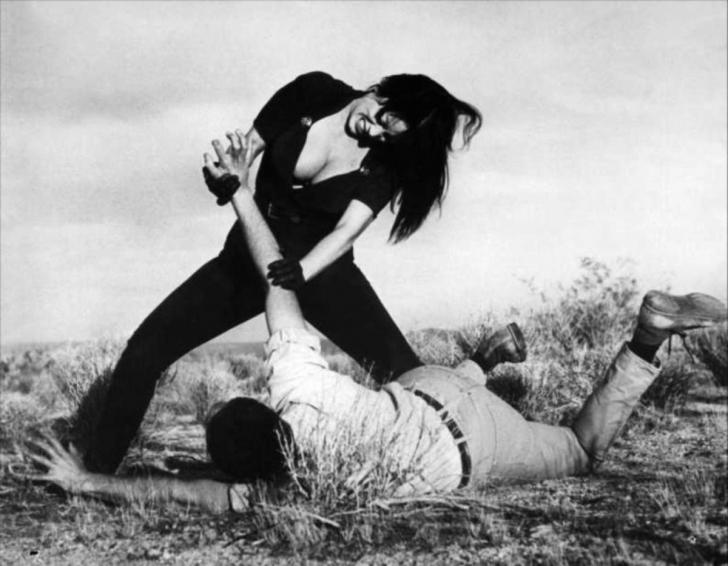
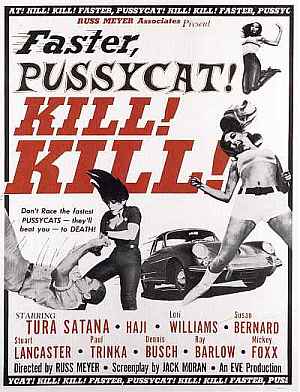
 Often neglected are the male contributors, in particular Stuart Lancaster as the target of their scheme. Though confined to a wheelchair, he rules his twisted clan with a rod of iron; in many ways, this is an ancestor of the family from Texas Chainsaw Massacre, with ‘the vegetable’ – as even his own father refers to him – a kinder, gentler version of Leatherface. Seeing the old man slobbering over Linda certainly shifts the audience, and helps to turn the murderous Varla and the other girls from villains into heroines, even as they progress their plan of robbery, because you sense their fate could end up being worse than death.
Often neglected are the male contributors, in particular Stuart Lancaster as the target of their scheme. Though confined to a wheelchair, he rules his twisted clan with a rod of iron; in many ways, this is an ancestor of the family from Texas Chainsaw Massacre, with ‘the vegetable’ – as even his own father refers to him – a kinder, gentler version of Leatherface. Seeing the old man slobbering over Linda certainly shifts the audience, and helps to turn the murderous Varla and the other girls from villains into heroines, even as they progress their plan of robbery, because you sense their fate could end up being worse than death.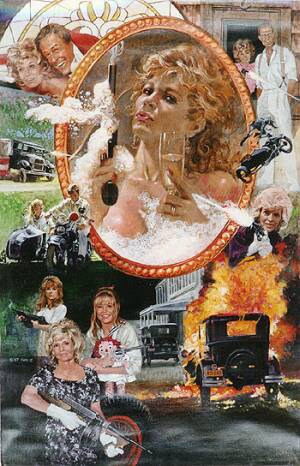 A Roger Corman production. Those four words cover much turf, both good and bad; this inclines toward the latter, simply because it takes an interesting premise, and goes next to nowhere with it. It’s less a sequel to, than a remake of the 1974 film, also starring Dickinson, which is generally believed to be superior. However, that isn’t on heavy cable rotation this month, so you’re stuck with the follow-up. Dickinson plays Wilma McClatchie, evicted from her home by uncaring businessman Morgan Crawford, and whose husband is killed in the process. She and her daughters Billie-Jean and Polly take up a life outside the law, but when Crawford makes a run for governor, their crimes take on a political perspective, as they aim to sabotage his campaign.
A Roger Corman production. Those four words cover much turf, both good and bad; this inclines toward the latter, simply because it takes an interesting premise, and goes next to nowhere with it. It’s less a sequel to, than a remake of the 1974 film, also starring Dickinson, which is generally believed to be superior. However, that isn’t on heavy cable rotation this month, so you’re stuck with the follow-up. Dickinson plays Wilma McClatchie, evicted from her home by uncaring businessman Morgan Crawford, and whose husband is killed in the process. She and her daughters Billie-Jean and Polly take up a life outside the law, but when Crawford makes a run for governor, their crimes take on a political perspective, as they aim to sabotage his campaign.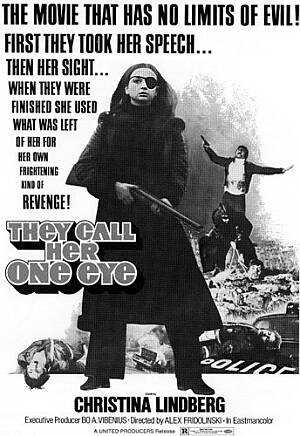
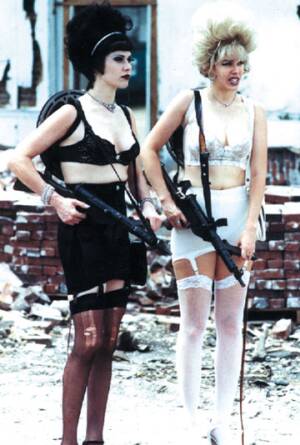 After civilization’s collapse, men have regressed to the level of Neanderthals, while women live in clans decided by their hair colour, with names like the FayWrays, Satanas and Tempests. Clothing is in short supply: lingerie, it would appear, is not, and nor are large, automatic weapons. Unsurprisingly, this leads perhaps to the finest opening five minutes in girls/guns cinema ever – “My name is Rachel, and I am a blonde. Blondes are extinct” – as our heavily-armed, suspender-and-stiletto clad heroines stagger round a post-apocalyptic landscape. This looks fabulous, and totally belies the fact that it cost $16,000 and was made in sixteen days.
After civilization’s collapse, men have regressed to the level of Neanderthals, while women live in clans decided by their hair colour, with names like the FayWrays, Satanas and Tempests. Clothing is in short supply: lingerie, it would appear, is not, and nor are large, automatic weapons. Unsurprisingly, this leads perhaps to the finest opening five minutes in girls/guns cinema ever – “My name is Rachel, and I am a blonde. Blondes are extinct” – as our heavily-armed, suspender-and-stiletto clad heroines stagger round a post-apocalyptic landscape. This looks fabulous, and totally belies the fact that it cost $16,000 and was made in sixteen days.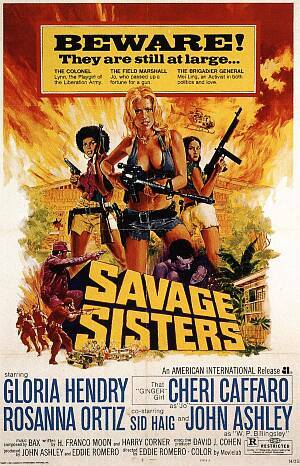 This Philippino phlick doesn’t quite have the courage of its convictions, and is never quite sure whether it wants to be sexploitation or serious drama. The poster promises a lot more than the film actually delivers, which is a shame, as the performances from the three leading ladies are nicely judged – as well as refreshingly multicultural. Two of them (Caffaro and Ortiz, one Caucasian, the other “Oriental”) are sent to prison, but when their torturer (ex-Bond girl Hendry, who initially comes over almost like a Black Ilsa) discovers they may know the whereabouts of a million bucks in cash, she helps spring them, and the trio head off, along with a local hustler (Ashley).
This Philippino phlick doesn’t quite have the courage of its convictions, and is never quite sure whether it wants to be sexploitation or serious drama. The poster promises a lot more than the film actually delivers, which is a shame, as the performances from the three leading ladies are nicely judged – as well as refreshingly multicultural. Two of them (Caffaro and Ortiz, one Caucasian, the other “Oriental”) are sent to prison, but when their torturer (ex-Bond girl Hendry, who initially comes over almost like a Black Ilsa) discovers they may know the whereabouts of a million bucks in cash, she helps spring them, and the trio head off, along with a local hustler (Ashley).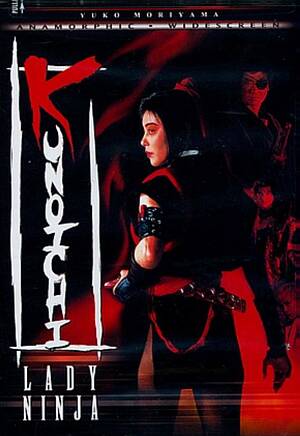 A combination of the seventh and eighth in the series, I believe it’s the first entry (I don’t
A combination of the seventh and eighth in the series, I believe it’s the first entry (I don’t